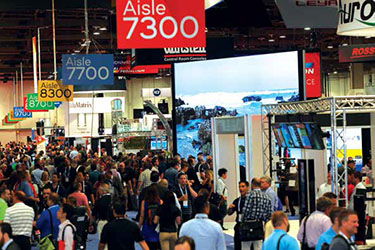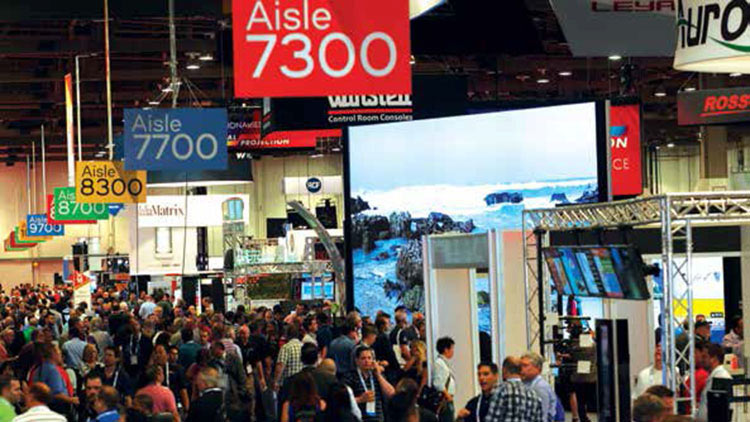Ready, set, go! When industry professionals descend on the Orange County Convention Center in Orlando next month for InfoComm 2017, they will be attending the largest pro AV trade show in North America.

With so much to see and so much to cover, attendees will be surrounded by a dizzying array of the latest and greatest technologies in AV, lighting and staging, digital signage and content creation, conferencing, networking, and, wait—there’s even more.
Integrators and consultants should be on the lookout for tech that can make their clients’ businesses more efficient and address end users’ desires. On the list are products implementing AES67 standards, AV over IP, direct-view display technology, and systems that speak to the convergence of AV onto network infrastructures.
With such an impressive array of exhibits and events, not to mention an imposing floorplan, a little InfoComm pre-show strategizing can go a long way to ensuring a successful and panic-free show visit.
The AV integrators and consultants we queried shared their best plans of action from a “divide-and-conquer” strategy, to a firm schedule, team texting, caffeinated beverage consumption, and of course, carefully selected footwear.

Mike Kirby
Director of Business Development and Marketing, GenComm
What we are always on the lookout for at the show is something we can actually sell to the end users. We see lots of fun advancements in technology but a lot of it doesn’t resonate with people outside the industry. What we get really excited about is something we can take to the end users, telling them that it will save them or make them money because of X, Y, or Z.
We saw some more IP-based products at ISE in Amsterdam, and we’ll be looking out for what else and who else can find creative ways to utilize network infrastructure. We serve clients across all verticals, and they’re starting to ask more and more about networked devices. Anything with AES67 or Dante adds value to what we can do and saves the client money.
Our typical game plan is to divide up the show, making sure we all get a little slice. Then we come back home and compare what each of us found. But if we find something earth shattering during the show, we’ll text the others and explain what everyone needs to go see.

Jay Myers
Founder/CEO, Interactive Solutions, Inc. (ISI)
I’m interested in enterprise team messaging solutions such as Spark, and end-user applications. Cisco seems to be “shaking up” stale videoconferencing applications more than anything I’ve seen in the past several years (other than Zoom). API integrations that auto connect with calendars or voice dial meetings (like Alexa or Siri) are much better user experiences than H.323 or SIP dialing. They also meet the expectations that consumer tech already delivers. We’ve actually started integrating Alexa into our conference room solutions and are getting great feedback.
I’d like to better understand how Cisco’s plans/strategies will affect traditional AV integration firms in the future. Companies like mine haven’t made much money developing bots before or embedding workflow into video solutions. Year after year, we’ve integrated hardware on top of hardware with traditional Crestron or AMX code—not too exciting for the most part.
Questions I have are these: What do we need to plan for as an AV integration firm in order to thrive in this new era of unified communications and collaboration technologies? This could be an unbelievable opportunity for the industry, but who is there to guide and coach the channel partners like ISI?
As an industry, we need to get past the current discussions around extremely crowded technologies like virtual meeting rooms, huddle rooms, and low-cost hardware endpoints. Even though the number of huddle rooms has increased significantly over the past few years in my particular market, it’s been hard to create value for us since the installation is just not that complex. Both huddle rooms and low-cost video endpoints are too much of a commodity sale these days; this only makes sense if there is a large, scalable enterprise opportunity. Our customers continue to ask for innovative AV technology that can help them run their businesses more efficiently.

Tim Hennen
President, Sales & Engineering, IVCi
We’re very excited to witness the unveiling of new products leveraging AVB, Dante, AES67, and other IP-based standards. Many manufacturers are making significant investments in this area, and we’re eager to view their recent developments.
Large-format display technology and video walls are constantly improving, and each day we’re seeing more products in this category. There’s been strong growth and adoption of digital signage in many corporate verticals. As this trend continues to gain momentum, we’re interested to see where it’s headed.
We’re excited to view the latest trends in collaboration technologies at the show. Over the past few years, we’ve seen a sharp rise in products aimed at improving physical meeting spaces. From huddle rooms to conference rooms and executive boardrooms, all the way to high-impact immersive collaboration rooms leveraging technologies from partners such as Oblong, Prysm, and Cyviz, there are a lot of creative solutions being developed in this space.
In response to the market’s growing demand for better team collaboration, we’ve witnessed tremendous innovations made in revolutionizing virtual meeting spaces. As a result, there’s a proliferation of new software platforms including Cisco Spark, Google Hangouts, Microsoft Skype for Business, Zoom, and others. We will be carefully studying this shift and the impact it will have on the physical meeting spaces we are building for our customers.
Our customers ask us for guidance. They recognize the need to optimize workflow, but they are overwhelmed by choices and fearful of committing huge investments in the wrong collaboration technology. They rely on us to stay ahead of industry trends, so they can get the latest solutions and an edge on their competition. We meet their business objectives and improve their bottom lines by handpicking the best solutions for their particular needs.
Divide and conquer is our game plan. There’s never enough time to cover everything at InfoComm, so each member of the IVCi team will be focused on a specific area. When we return from the show, we will meet and everyone will present on their specific segment. We will then define the key takeaways from the event and determine how these trends affect IVCi’s strategies.

Ben Bausher
Senior Consultant, Audio & Video Systems Group, JaffeHolden
I am interested in hearing the new L-Acoustics Syva loudspeaker. There are plenty of loudspeakers out there, but it occupies a unique niche since it is both very high-output as well as a passive speaker. And I will be looking for how AES67 is being implemented in various products; it has a lot of promise to lead the industry forward for device interoperability—getting everything to “play nicely” with each other will be the key to its success. I will be looking for further implementation of laser projection into a more diverse range of products at both small and large scales.
I will also be looking for 4K camera solutions that address signal transport in a nonproprietary fashion. We have clients who want a 4K upgrade path but can’t afford an end-to-end 4K system just yet. There isn’t a single standard for 4K signal transport yet that gives us everything we need, so I’m keeping my eyes open for possible solutions.
My approach to the show floor is pretty exhausting, but it usually works out pretty well. I can sleep on the flight home, right? I keep a mental tally of the reps that regularly call on us, and since they serve us pretty well in keeping us up to date on the latest offerings from their respective companies, I usually don’t go to those booths in the interest of time. I start on the end of the convention center opposite the audio pavilion (if I started in audio, I’d never leave…) and then work my way up and down the various aisles, noting what’s new or interesting. I make a goal of covering the entire show floor in one-and-a-half days in this fashion—a quick sprint, if you will. Then I follow up with the individual booths that I noted on my initial walkthrough. I go to speaker demo rooms on Tuesday afternoon, and then again toward the end of the day on Thursday and Friday. This will be the first year I’ve had my phone configured for counting my steps, and I’m curious to see how much ground I cover!

Mark Grassi
Principal Consultant, The Sextant Group
I’m particularly excited to see the advances in AV-over-IP technologies. Everything in our industry, including video, audio, and control, has been constantly shifting into the networked space. We are closer than ever to having a truly converged AV and IT world, and it’s exciting to see where the next stage will take us.
We’re continuing to see a shift away from “boxes” and more toward cloud-based or hardware-agnostic software applications. I suspect we will see more and more of this in the future.
Most organizations have invested large amounts of money into their AV technologies and are now starting to scratch the surface of the next-level of ownership, the management of these investments. With a full convergence of AV onto a network infrastructure, an owner, no matter the market, is able to start leveraging management tools to fully see the value of these investments.
My strategy for InfoComm includes comfortable shoes and carrying as few marketing materials from manufacturers as possible. Oh, and coffee.

Mark Alspach
Principal, Audiovisual Discipline Head, Shen Milsom & Wilke
We are interested in large-scale, finepitch, direct-view display technology, for one. InfoComm is perhaps the best opportunity to see these products operating in one place. We really appreciate the effort that the manufacturers and InfoComm make to provide us with this opportunity. Another one is the high-bandwidth, low-latency, network-based content distribution solutions.
AV has been undergoing the shift first from analog distribution to digital distribution, and now to IP network-based distribution. The game is ever changing. We are increasingly amused by an industry that can’t perfect the current trend before announcing the next gee-wizardry. Witness the recent trend from HD to 3D, to 4K, and now 8K. There is too much competition in the consumer market, which seems to drive these trends.
The trend toward network-centric systems has created an environment characterized by claims for performance that conflate specifications for resolution, frame rate, dynamic range, and so on. Combine this with a lack of specificity of requirements for network support to propagate this information and one might get the impression that the highest quality video content can be delivered by a typical, administrative network. We are looking for end-to-end solutions that will help us design, specify, and implement the new solutions with a better comfort level for success. We are finding that our typical resources for implementation and coordination with our client’s IT people may be weak on the IT systems side when it comes to delivering and commissioning these network-centric solutions.
At SM&W, we are lucky, as we have been delivering consulting on both IT and AV for years. Right now, we have combined our AV, IT, and security management into a single technology department. Our specifications are now requiring that the contractors who build our projects have resources dedicated to the project and have certifications in IT systems technology. We think that the manufacturers who provide these AV/IT products should also require their dealers to have similar qualifications, and some of them already do.
Same as always, customers are comparing the technology they find in their homes and personal devices with what they find in their conference rooms, boardrooms, and auditoria. For instance, a client with a structural vibration problem wonders why his $5,000 PTZ camera doesn’t have the image stabilization capabilities that are built into his smartphone camera. It’s a matter of scale: Manufacturers can put a lot more investment into products that will sell in millions of devices versus those that sell in the hundreds of thousands.
Show strategy is a challenge year after year for us. We typically send 20 to 30 consultants to InfoComm. We think it is the seminal event each year for AV. There is a perfect storm of reps who want to take us on a “booth tour” of all manufacturers on their line card, manufacturers who want to address the entire SM&W group as a whole, and then our own organizational and individual priorities. It’s like herding cats! We will have a schedule of events that we arrange ahead of time, and then we have the “Steve Emspak Breakfast” where every morning at the show, we get together for breakfast and discuss what we will do that day, exchange comments about what we have experienced thus far, and then coordinate the day’s activities. Best thing about this? Steve pays.
Matthew Kosel
Systems Designer, Spinitar
There is still a lot of excitement about direct-view LED. LED looks great, and I am excited to see what advancements have been made to make this solution more viable in more applications.
The huddle room has been a trend in space planning for some time, but the technology integration has not had the impact we thought due to cost or form factor. Huddle spaces are becoming more prominent in higher education, not just the corporate business sector, making demand for solutions much more common.
I will be looking for new huddle space solutions that will be able to meet the functionality requests of the end users at price points that will accommodate large numbers of deployment.
And my show plan features comfortable shoes, caffeine, and a little luck.
Karen Mitchell is a freelance writer based in Boulder, CO.
